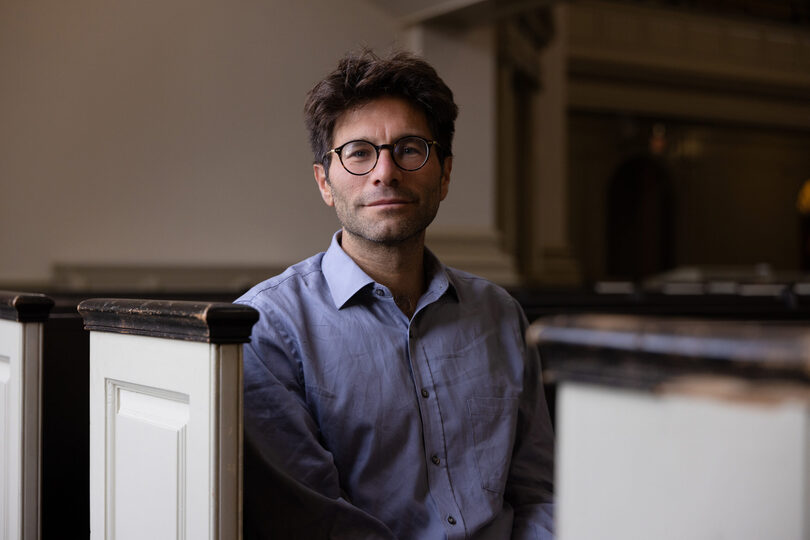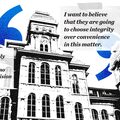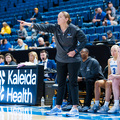Decades abroad, interfaith focus set Rabbi Levy on path to SU Jewish chaplaincy

New Rabbi Natan Levy intends to continue reinforcing previous interfaith initiatives at Syracuse’s Hendricks Chapel. Levy steps into Rabbi Ethan Bair’s spring vacancy as SU’s newest Jewish chaplain with more than 20 years of experience. Ella Chan | Senior Staff Photographer
Get the latest Syracuse news delivered right to your inbox.
Subscribe to our newsletter here.
Rabbi Natan Levy’s path to chaplaincy was an unusual one.
Levy was always familiar with his Jewish cultural roots, but he wasn’t in touch with his religion growing up until it became an integral part of his self-identity.
What initially began as a six-month trip to Israel to immerse himself in Judaism eventually became a six-year-long, “life-changing journey,” he said.
“I wanted to engage with the rabbinical model of how asking questions are always better than having answers,” Levy said. “Religion wasn’t a way to close down conversations or beliefs. It was a way to ask questions about our relationship with God, with each other, our purpose and mission in life.”
Bringing over 20 years of experience in university and community chaplaincy with him, Rabbi Levy was appointed Hendricks Chapel’s Jewish chaplain in July after former Rabbi Ethan Bair did not return.
Levy’s journey first began in Israel, where he focused on receiving his rabbinical ordination. He became the Jewish chaplain at the University of Bristol in 2005, leading to an inspiring encounter that encouraged Levy to dive into interfaith initiatives.
At Bristol, he was approached by the heads of the Jewish and Muslim student leadership teams about the lack of kosher and halal food choices on campus. Watching the two students work together to get their proper food options on campus shelves heavily influenced Levy’s chaplaincy trajectory, he said, especially after his move to London in 2008.
Though London is home to many different faiths, Levy said communities often stay congregated within each other, ultimately leading to forthcoming challenges and tensions. His first interfaith encounter changed the way Levy handled community events and issues, he said.
“When I got to London, the opportunity to do interfaith work kept growing, from environmental activism to refugee rights. We weren’t always successful, though,” Levy said. “If a rabbi was planting a tree, not everything is going to turn into paper. But if you’re with an imam, a rabbi and a priest, you will get a story that’s worth telling.”
For Levy, Hendricks Chapel was a beacon of light that drew him to SU. Hendricks’ longstanding history with interfaith work and student religious engagement made it easy for Levy to decide his next chapter in chaplaincy, he said.
Though it was a coincidental run-in in May that cemented Levy’s decision to move to Syracuse.
While volunteering for a food recovery site in Israel, Levy ran into a group of Syracuse Hillel students who were volunteering at the same farming site.
“(The students) were kind to the volunteers and you could see there was a level of care about what they were doing. And they just got off a red-eye flight, which is pretty impressive,” Levy said. “After not sleeping for 24 hours straight, they still wanted to volunteer and still had a level of real passion and kindness.”
Since his appointment to Hendricks, Levy has leaned on Hillel for guidance on the ebbs and flows of the organization. For now, Levy’s duties are to motivate students to pursue their passions outside of their academics.
Hillel President Sadie Meyer has seen firsthand how Levy has already familiarized himself with the organization. From attending FreshFest, a pre-welcome program for incoming Jewish freshmen, to helping Hillel for upcoming holidays like Rosh Hashanah and Yom Kippur, it has been an all-hands-on-deck experience for Levy, she said.
“He obviously cares about this environment and he’s been very welcoming to our students,” Meyer said. “For every (new) rabbi that comes in, it’s a big transition period (for them), but he’s been doing a fabulous job. I have nothing but good things to say about him.”
While getting acquainted with student organizations is a priority for Levy, he said he hopes to continue building off the previous interfaith initiatives at Hendricks. As a start, Levy attended the August 2025 Interfaith America Leadership Summit in Chicago with Imam Amir Durić and several other religious student affinity groups.
During the summit, sophomore Ronit Hizgiaev said she saw Levy’s kindness extend beyond attending events and other commitments, even inviting her to Shabbat dinner at his mother’s house.
“I got to not only know the Rabbi more, but I also got to talk about their background, everyone’s careers and passions,” Hizgiaev said.
As a student representative who attended the summit, Hizgiaev saw firsthand how interfaith initiatives hold importance in today’s climate. Though Hizgiaev was initially not very involved with Hillel, she has since become the organization’s multicultural chair, using her experience at the summit.
Engaging in conversations with Hendricks interfaith leaders about the current campus climate and continuing initiatives like the Jewish Muslim Fellowship started by Rabbi Bair and Imam Durić, developing interfaith projects is the key to fostering social progress, Hizgiaev said.
“When we all work together and we’re like-minded, we’re working towards a greater good,” Hizgiaev said. “The work of Interfaith America is so amazing, and I would love to get more involved in what they do. It gives me a lot of hope.”
As his first year at Hendricks begins, Levy said he hopes to remain an approachable figure for those of all faiths. Whether it be seeking advice or helping with a service, Levy aims to continue his interfaith work.
Levy said he found interfaith work necessary to maintain hope in tough times, recalling a Hadith told by his friend, who is an Imam. When Abraham was stuck in the burning flames, a small bird attempted to put the fire out with its small beak, Levy remembered his friend telling him. Though the other animals made fun of the bird, it persisted.
“At the end of the day, they’re not going to ask if I put out the flames. They’re going to ask what I did when the fire was burning. That question has always sat with me,” Levy said. “With a very tiny beak, you might not be able to put out the flames. But if you get a lot of people together with their beaks, maybe that can put up the flames.”






